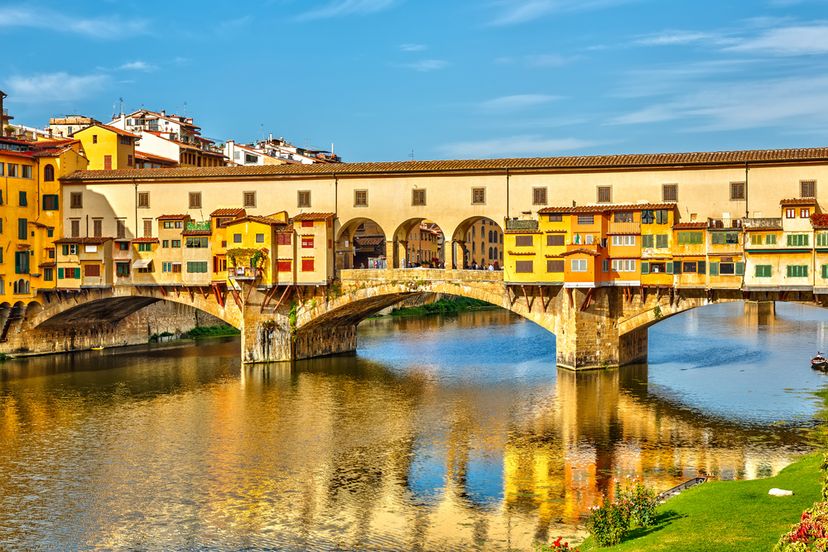
Florence is the capital city of Italy’s Tuscany region and is historically famous as it’s considered the birthplace of the Italian Renaissance. With a population of approximately 380,000, it is also the most populous city in the Tuscany region. Florence was proclaimed a World Heritage Site in 1982 and is rich in culture with its Renaissance art, architecture, monuments, palaces, churches, numerous art galleries and museums. This incredible heritage has given it the distinction of being called one of the most beautiful cities in the world by Forbes Magazine and is ranked among the top 50 fashion capitals of the world. You can roam some of the oldest streets in the city to the Arno River and the see the newest area of Florence called the “Oltrarno”. Whether you enjoy museums, old architecture, art or the outdoors, there is something breathtaking and awesome to see in this incredible city.
Advertisement
10. Florence Street Sign Art
While traveling through Florence, you may notice something a little unusual about the street signs. Though all the other historical architecture and beauty around you may distract you from paying much attention to the street signs, (especially if you’re traveling on foot) it’s worth paying attention. The signs are a virtual pop art exhibition. An artist by the name of Clet Abraham living in Italy for over 20 years, has been enhancing Florence’s visual experience by altering the traffic signs adding stickers and secretly creating humorous scenes out of the ordinary signage posted all over the city. Since the stickers are removable, his artwork is often short-lived but not unnoticed or unappreciated. He has created some controversial works of art as well but it’s mostly received with great admiration. Over the years, the municipality has come to accept his work and it is slowly becoming quite a tourist attraction. Clet actually has a studio in Via Dell’Olmo where you can buy stickers and see more of his work. Whether or not you have children with you, discovering the hidden treasures created by Clet is an enjoyable experience for all.
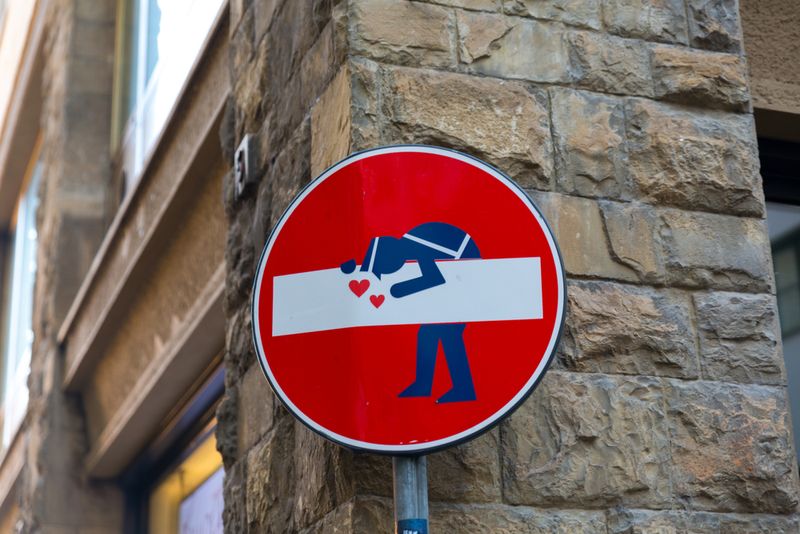
9. Shopping
While visiting Florence, you will want to take the opportunity to visit some of the numerous shops located here. There are vintage shops, designer boutiques and luxury shops you won’t want to miss while looking for something new and fashionable or for some souvenirs to take home. Via Tornabuoni, Via della Vigna Nuova, and Via dei Calzaiuoli are home to many luxurious shops, designer boutiques and jewelry stores. If you have a little money to burn, you’ll want to visit these streets in the Santa Maria Novella district or you can at least window shop and dream of owning them one day. Via Maggio is known as the destination for antique collectors. Located near Pitti Palace, the street is full of antique shops featuring treasures from as far back as the Renaissance. The San Lorenzo Market features many leather shops if you are looking for a new bag or jacket. For those looking for something a little more budget friendly, a stop at some of the outdoor flea markets located in and around Mercato Centrale in the San Lorenzo district is a great place to shop for just about anything including great food to sustain you on your journey.

8. The Florence Baptistery
The Florence Baptistery, also known as Baptistery of Saint John is a minor basilica in Florence. It’s an octagonal building standing in both the Piazza del Duomo and the Piazza di San Giovanni. It was constructed sometime between 1059 and 1128 in the Florentine Romanesque style making it one of the oldest buildings in the city. It’s renowned for its three artistic sets of bronze doors featuring relief sculptures created by Andrea Pisano and Lorenzo Ghiberti. Michelangelo called the east doors the Gates of Paradise. Many historically significant people were baptized here including the poet Dante, members of the Medici family and other notable people of the Renaissance. By the end of the 19th century, all Catholic Florentines were baptized here. The octagonal shape has become commonplace for baptisteries since the number eight is a symbol of regeneration in Christianity. Under the roof on the corners are lions’ heads with human heads under their claws. On the west side is a rectangular apse and on the roof there is an octagonal lantern. It is a beautiful holy building to enjoy while visiting the city.
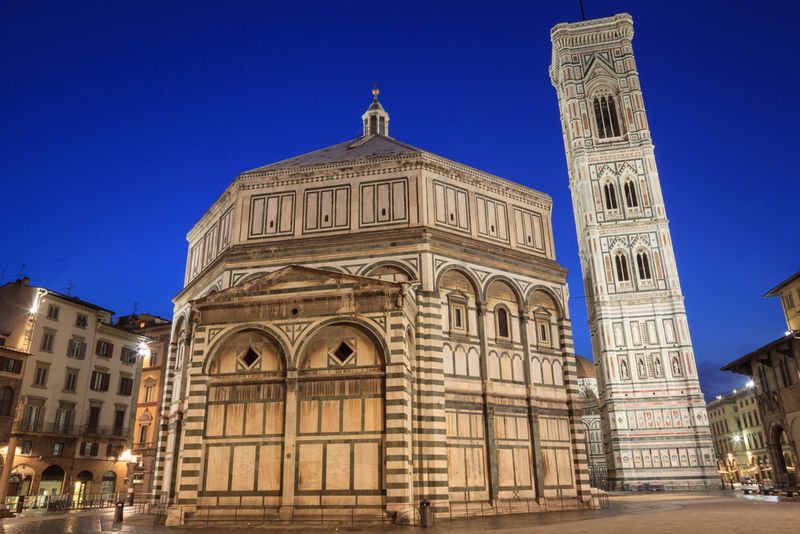
7. Ponte Vecchio
The Ponte Vecchio or Old Bridge is a medieval stone bridge crossing the Arno River featuring closed-spandrel segmental arches. The bridge is well known for having shops built along it and though in the past the shops were occupied by butchers, they are now home to jewelers, art dealers and souvenir vendors. There are two other bridges crossing the river as well -Ponte Santa Trinita and the Ponte alle Grazie. It is believed that the concept of “bankruptcy” originated here when a merchant could not pay his debts and the table he used to sell his wares (banco) was broken (rotto) by soldiers. This practice was called bancorotto (broken table) and possibly became banca rotta meaning broken bank since the merchant had no more table or place to sell his wares. There are many padlocks along the bridge popularly connected to the idea of love. It’s thought that by locking the lock and throwing the key into the river, the lovers are eternally connected. However, there is now a fine for doing this, so the frequency of this practice has decreased substantially.
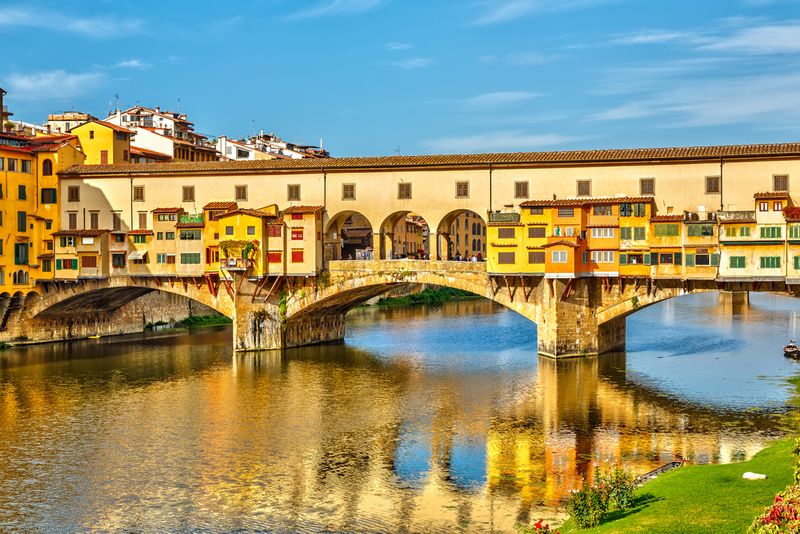
Advertisement
6. Pitti Palace
The Pitti Palace (Palazzo Pitti) is an enormous Renaissance palace situated on the south side of the Arno River near the Ponte Vecchio. It was purchased by the Medici family in 1549 and served as the chief residence of the families of the Grand Duchy of Tuscany. Through the years, many treasures were amassed by the families and it has since become a museum displaying paintings, plates, jewelry and other luxurious collections. In 1919, the palace and its contents were donated to the people of Italy by King Victor Emmanuel III. It’s the largest museum in Florence with its main palazzo block measuring 32,000 square meters and divided into several galleries. The main gallery is known as the Palatine Gallery housing over 500 (primarily Renaissance) paintings which were once part of the Medici family collection displayed as it would be in a private collection. The works are hung and displayed as they would have been in grand rooms as they were intended rather than in chronological order or according to school of art. The other galleries also consist of numerous rooms and incredible works of art.
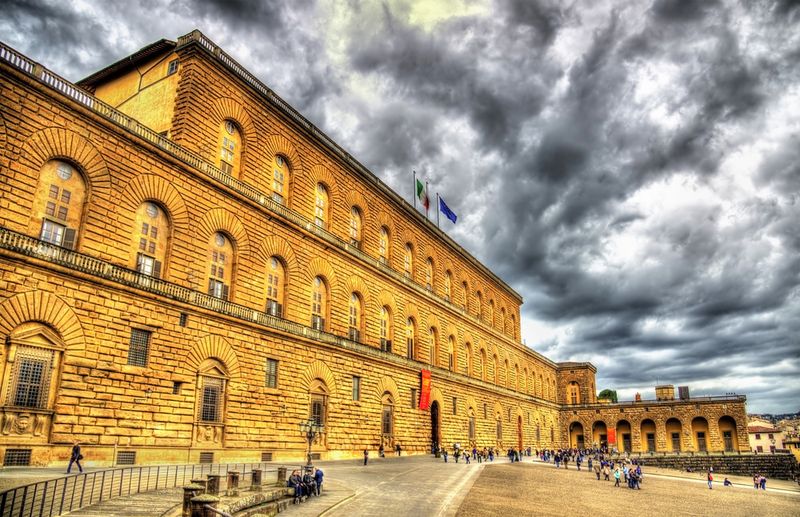
5. Boboli Gardens
The Boboli Gardens is a picturesque park located in Florence with one of its main features being a collection of sculptures dating from the 16th to the 18th centuries and some Roman antiquities. Located behind the Pitti Palace, the gardens are some of the first and most familiar formal Italian gardens of the 16th century. The layout provides wide gravel walkways, statues and fountains and many incredible details incorporated into the semi-private and public sectors making it an exquisite pleasure to experience. The lavishness of the gardens was unprecedented in its time only to be enjoyed by the Medici family since no parties or entertainment were ever hosted there. Because there is no natural water source to the gardens, a conduit was built to the Arno River to feed water into an elaborate irrigation system. You won’t want to miss a stroll through these Gardens while in Florence. The artistry and natural beauty is breathtaking and the Amphitheater and Andromeda fountain are works of art only enhanced by nature’s hand.
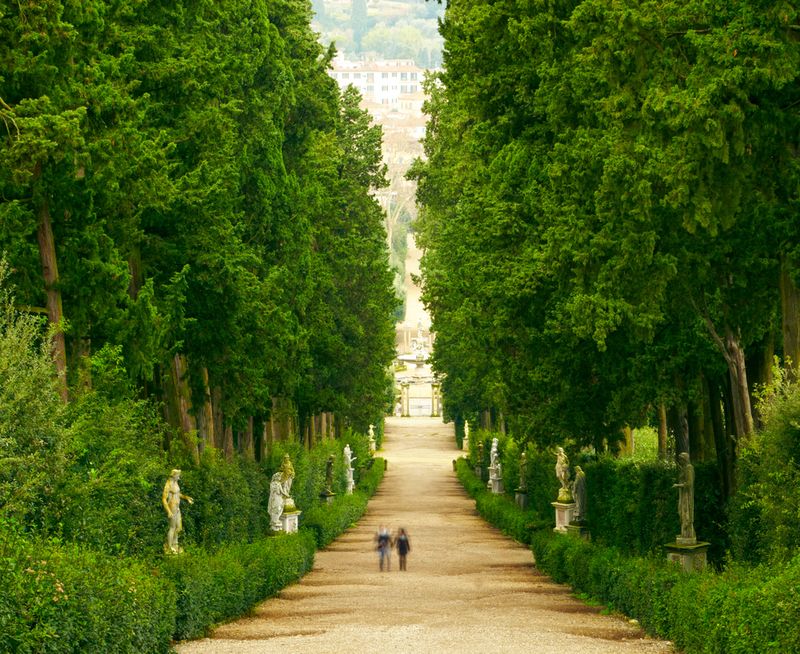
4. Basilica of Santa Croce
The Basilica of Santa Croce (Basilica of the Holy Cross) is a minor basilica of the Roman Catholic Church and a principal Franciscan Church located in Florence. Located in the Piazza di Santa Croce, it’s the burial place of many historically important and famous Italians like Michelangelo, Galileo, Machiavelli, Foscolo, Gentile and Rossini, giving it the moniker The Temple of the Italian Glories (Tempio dell’Itale Glorie). With 16 chapels displaying many frescoes, tombs and cenotaphs, it is the largest Franciscan church in the world. Inside is a magnificent floor plan of a Tau Cross (a symbol of St. Francis) 115 meters in length with a nave and two aisles separated by octagonal columns. The 19th century facade consists of an ornate design with a Star of David prominently displayed in the center. In the cloister, there is a monument dedicated to Florence of Nightingale who was born in Florence and named after the city. The former dormitory of the Franciscan friars is now the location of the Scuola del Cuoio (Leather School) where visitors can watch creations being made for sale in the adjacent shop.
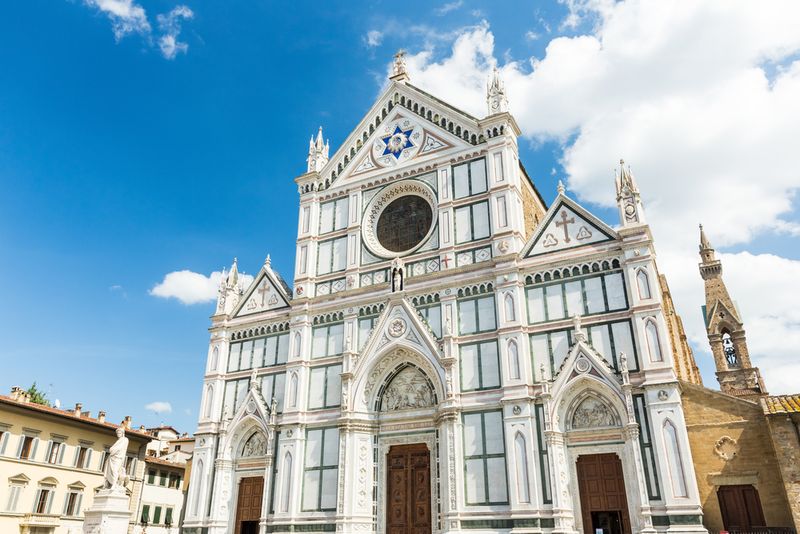
3. Piazzale Michelangelo
Piazzale Michelangelo is the premier place to have a panoramic view of Florence. It’s a public square with observation points offering a magnificent perspective on the city below. The square was built in 1869 on a hill just south of the center during the “rebirth” of the city’s middle class. It was dedicated to the famous sculptor Michelangelo…hence the name. Some bronze copies of some of his famous marble works can be found there, such as David and the four allegories of the Medici Chapel of San Lorenzo. This popular tourist spot offers more than just an amazing view of Florence and the Arno Valley. When the terrace was being built, a hillside building was added intended as a museum to display Michelangelo’s sculptures but that never materialized and now the building houses a restaurant where many visitors enjoy a meal while taking in the view. You can access the Piazzale by car along a lovely tree-lined street called Viale Michelangelo, take a tour bus ride or on foot up the stairs or ramps from the Piazza Giuseppe Poggi. However you decide to get there, don’t forget to bring a camera to preserve the picture perfect beauty for a lifetime.
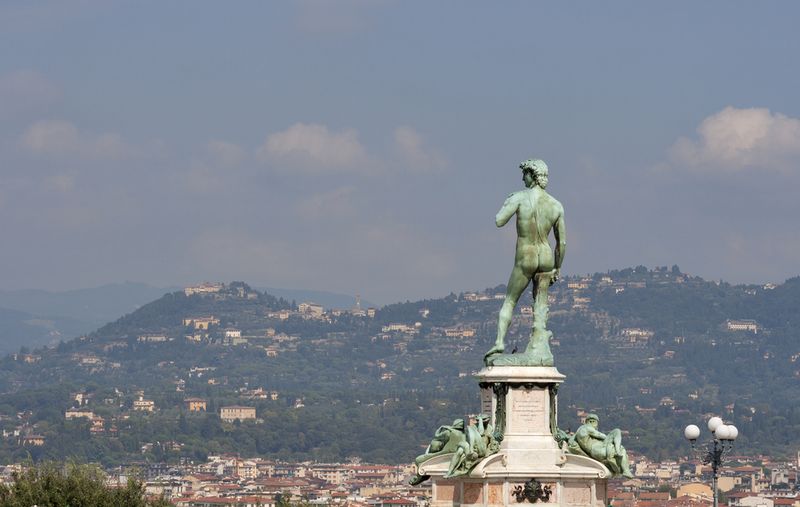
2. Uffizi Gallery
Built at the request of Francisco de’ Medici in 1581, the Uffizi gallery is the primary art museum of Florence and one of the best known museums in the world, housing art mostly from the Renaissance. It’s home to some extraordinary pieces of work by world renowned artists such as Botticelli, Giotto, Michaelangelo, Leonardo da Vinci and Raffaello to name a few. The works from all centuries are featured here, though the largest part of the collection dates from the 12th to the 17th centuries. The Uffizi Gallery welcomes more than a million visitors annually and with good reason. This must-see destination houses some of the world’s most famous artists and their masterpieces. The Gallery is currently under extensive renovations to help ease your visit with modernization as well as making improvements to the preservation of the works within it. The museum is still open while these improvements are being made, but things could be moved around. Since it’s spread out across three storeys, you will want to plan your visit ahead of time to find out what stage renovations are at, so you will get to see what you want to see.
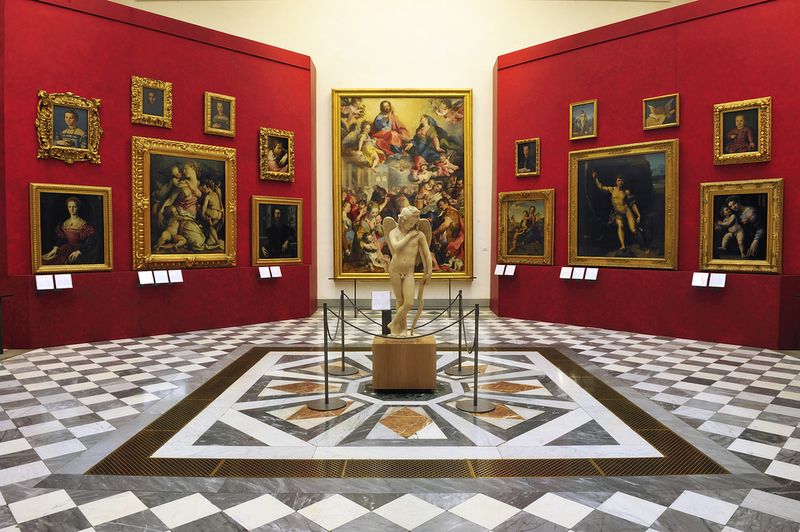
Advertisement
1. Florence Cathedral
The Florence Cathedral or Cathedral of Saint Mary of the Flower, is the main church of Florence. Construction on the Gothic style building began in 1296 and it was structurally completed in 1436. The basilica face consists of polychrome marble panels in different shades of green and pink and bordered in white, accented by a 19th century Gothic revival facade. Located in the Piazza del Duomo, the cathedral complex consists of three major buildings and include the Baptistery and Giotto’s Campanile. They are a major tourist attraction in Tuscany right in the heart of the historic center of Italy. The basilica is one of the largest churches in Italy featuring the largest brick dome ever constructed. It was built on the site of the church of Santa Reparata and the remains can still be seen in the crypt. A statue of the architects responsible for the building and dome can be seen overlooking their masterpiece to the right of the cathedral. The inside of the cathedral is quite plain comparatively, but features attractive mosaic pavements, the not so common working clock above the entrance and intricate artwork. It’s quite cool in the summer making it a wonderful place to escape the heat and take in some history.
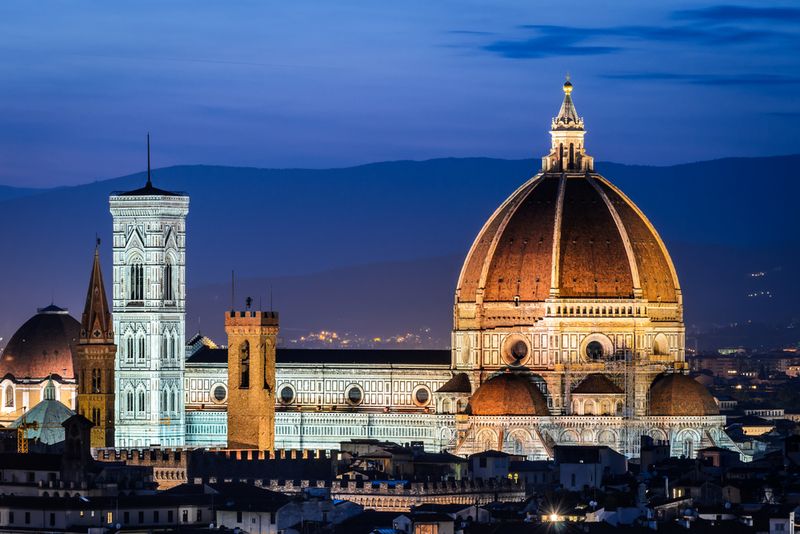
Advertisement